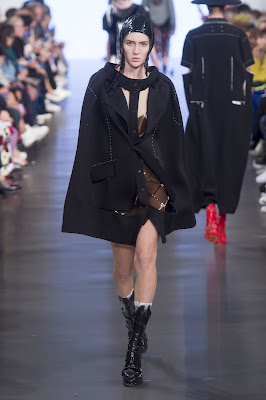Maison Margiela. Spring 2019 – Paris Fashion Week
John Galliano returns with his continued breaking down of structural aspects of fashion and its design. To the point where it may become either anew or vanish all together as a concept. Interesting perspective of attempting to rediscover ones roots. As an observation of what is projected from Galliano's latest collection. Is also an existential question with a general answer that still paradoxically asks the question. How far do you go backwards to reset a time and place that is all but gone? For memories? Maybe, as we all are getting older. To recollect is to feel an achievement. Yet, the past should be gently laid to rest. And it can been seen with established fashion designers who are embracing a soul searching mission backwards. Which, in my opinion is counter intuitive, as within human nature; there is only a time line of a start and an end. What ever lies in between should not be squandered in idleness. As Aldous Huxley once said, “Most human beings have an almost infinite capacity for taking things for granted"
Noted with my Spring 2019 A.F Vandevorst review, generations who have lived as teens and adults throughout the 1980s, 1990s would know that something has gone amiss in the 21st Century (beyond the age gap) in reference to digital interconnection and slogans that once meant something within the 'underground' are now used as marketing ploys with its advertising jargon - to feed the divisive (and banal) culture wars initiated by the marketers in association with politicians via social media hubs. Galliano for Maison Margiela in a respectful way, is showing his roots to the newer generation. Where, the internet did not exist, digital communication, 'smart' phones, fast tracked commentary, social media all began to have impact on culture in the mid 1990s - at a time when one couldn't afford or even have access too. The vast difference between pre global social networks and the now, is rebellion back then was new and significant. It didn't look for acceptance to appease or sell equality as a hashtag indulgence, it rather wanted to go in another direction. It refuted traditionalism in a celebratory expression, against the weight of left and right of politics. As the fashion designers, particularly from London in the 1980s experimented in such a creative way. They were poor, desperate and hungry. With a passion. Neither looking for or interested in being accepted as they had their own culture. This is where degrees of respect can been seen with Maison Margiela's Spring 2019 collection.
Noted with my Spring 2019 A.F Vandevorst review, generations who have lived as teens and adults throughout the 1980s, 1990s would know that something has gone amiss in the 21st Century (beyond the age gap) in reference to digital interconnection and slogans that once meant something within the 'underground' are now used as marketing ploys with its advertising jargon - to feed the divisive (and banal) culture wars initiated by the marketers in association with politicians via social media hubs. Galliano for Maison Margiela in a respectful way, is showing his roots to the newer generation. Where, the internet did not exist, digital communication, 'smart' phones, fast tracked commentary, social media all began to have impact on culture in the mid 1990s - at a time when one couldn't afford or even have access too. The vast difference between pre global social networks and the now, is rebellion back then was new and significant. It didn't look for acceptance to appease or sell equality as a hashtag indulgence, it rather wanted to go in another direction. It refuted traditionalism in a celebratory expression, against the weight of left and right of politics. As the fashion designers, particularly from London in the 1980s experimented in such a creative way. They were poor, desperate and hungry. With a passion. Neither looking for or interested in being accepted as they had their own culture. This is where degrees of respect can been seen with Maison Margiela's Spring 2019 collection.
Gender fluidity (described by Galliano's "Coed" Spring 2019 collection) seen as the aesthetics to mix both male and female styles to fuse as one, is not new. It's old. Dating back over hundred plus years of fashion experimenting with male and female styles, breaking them down to create what is also known as the androgynous look. The problem with this, which is easy to define. And it is not a judgment. Is that the visual reality in designing and crossing the sexes over into switched styles is this; women look good in male clothing, they are more visually more fluid than a man. Men will struggle crossing over into female fashion styles unless they are embracing it as a novelty. Thus, female models wearing a deconstructed Galliano coat with tailored dotted lines (for later alterations) respecting the roots of old 'fitted' styles. Or course works. To which, Galliano, referenced early punk (before leather jackets) re-cut and restyled conservative styled blazers as a rebellious counter culture aspect - bought or stolen from thrift shops of the time. What generally happens with styles becoming 'coed', it is the feminine that embraces male fashion aesthetics, not vice versa.
As mentioned, the Margiela's Spring 2019 collection retains Galliano's layering and re-cutting established looks, drawing it back to its rawness, prior to a completed outfit. Unfinished and exposed stitching, rough cuts, incomplete tailoring and looks. Stylishly messy, but at times reverting back to set piece styles. (seen with the clean looks of skintight latex pants, blazers and exaggerated bowler hats). Which may indicate where Galliano is heading as far as resetting back to a less experimental range.
Ambiguity should be "fluid" and that is yet to be achieved with Galliano's latest collection, rather what maybe seen as risque ends up being homogeneous.








Comments
Post a Comment